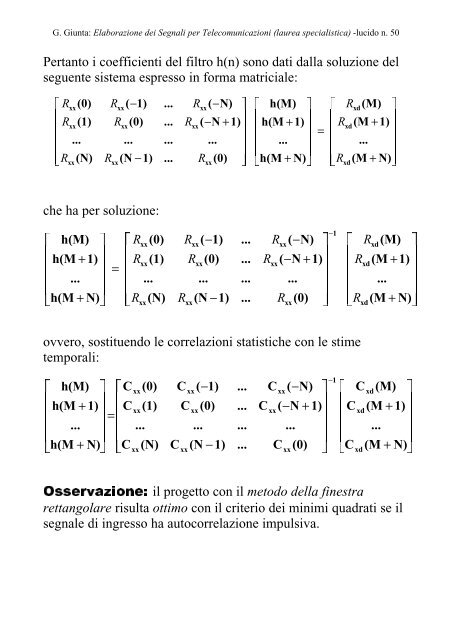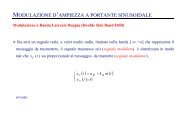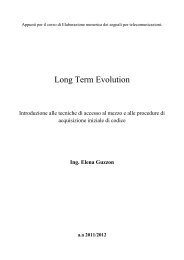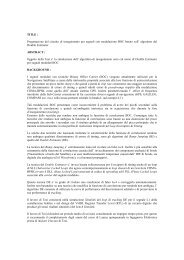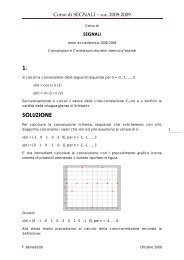G. Giunta, Lucidi del corso Elaborazione dei Segnali per ... - Comlab
G. Giunta, Lucidi del corso Elaborazione dei Segnali per ... - Comlab
G. Giunta, Lucidi del corso Elaborazione dei Segnali per ... - Comlab
You also want an ePaper? Increase the reach of your titles
YUMPU automatically turns print PDFs into web optimized ePapers that Google loves.
G. <strong>Giunta</strong>: <strong>Elaborazione</strong> <strong>dei</strong> <strong>Segnali</strong> <strong>per</strong> Telecomunicazioni (laurea specialistica) -lucidon.50<br />
Pertanto i coefficienti <strong>del</strong> filtro h(n) sono dati dalla soluzione <strong>del</strong><br />
seguente sistema espresso in forma matriciale:<br />
⎡ ⎤<br />
⎡ ⎤ ⎡ ⎤<br />
Rxx(0) Rxx( −1) ... Rxx(<br />
−N) h(M)<br />
R (1) R (0) ... R ( − N + 1) h(M + 1)<br />
R (N) R (N − 1) ... R (0) h(M + N)<br />
Rxd(M)<br />
Rxd(M<br />
+ 1)<br />
...<br />
R (M + N)<br />
⎥<br />
⎢ ⎥ ⎢ ⎥ ⎢<br />
⎥<br />
⎢ ⎥ ⎢ ⎥ = ⎢<br />
⎥<br />
⎢<br />
xx xx xx<br />
... ... ... ... ...<br />
⎢ ⎥ ⎢ ⎥<br />
⎥<br />
⎢ ⎥ ⎢ ⎥ ⎢<br />
⎥ ⎢ ⎥<br />
⎣ ⎦<br />
⎣ ⎦ ⎣ ⎦<br />
⎢ xx xx xx<br />
xd<br />
che ha <strong>per</strong> soluzione:<br />
h(M)<br />
h(M + 1)<br />
⎡ ⎤<br />
⎥<br />
⎢<br />
⎥ =<br />
⎢<br />
...<br />
h(M N)<br />
⎡ ⎤<br />
⎡ ⎤<br />
Rxx(0) Rxx( −1) ... Rxx(<br />
−N) −1<br />
R (1) R (0) ... R ( − N + 1)<br />
⎥<br />
⎢<br />
⎥<br />
⎢ xx xx xx<br />
... ... ... ...<br />
R (N) R (N −1)<br />
... R (0)<br />
Rxd(M)<br />
Rxd(M<br />
+ 1)<br />
...<br />
R (M + N)<br />
⎢ ⎥<br />
⎢ ⎥<br />
⎥<br />
⎢ ⎥<br />
⎢ ⎥<br />
⎢<br />
⎥<br />
⎢ ⎥<br />
⎢ ⎥<br />
⎢<br />
⎢ ⎥ ⎢ ⎥<br />
⎣ ⎦ ⎣ ⎦ ⎣ ⎦<br />
+ xx xx xx<br />
xd<br />
ovvero, sostituendo le correlazioni statistiche con le stime<br />
temporali:<br />
⎡<br />
⎢<br />
⎢<br />
⎢<br />
⎢<br />
⎣<br />
h(M)<br />
h(M + 1)<br />
...<br />
h(M + N)<br />
⎤<br />
⎥<br />
⎥<br />
⎥<br />
⎥<br />
⎦<br />
=<br />
⎡<br />
⎢<br />
⎢<br />
⎢<br />
⎢<br />
⎣<br />
C<br />
C<br />
C<br />
xx<br />
xx<br />
...<br />
xx<br />
(0)<br />
(1)<br />
(N)<br />
C<br />
C<br />
C<br />
xx<br />
xx<br />
xx<br />
( −1)<br />
...<br />
(0)<br />
(N − 1)<br />
...<br />
...<br />
...<br />
...<br />
C<br />
C<br />
( −N)<br />
( −N<br />
+ 1)<br />
C<br />
...<br />
xx<br />
(0)<br />
⎤<br />
⎥<br />
⎥<br />
⎥<br />
⎥<br />
⎦<br />
−1<br />
⎡<br />
⎢<br />
⎢<br />
⎢<br />
⎢<br />
⎣<br />
C<br />
C<br />
C<br />
xd<br />
xd<br />
xd<br />
(M)<br />
(M + 1)<br />
...<br />
(M + N)<br />
Osservazione: il progetto con il metodo <strong>del</strong>la finestra<br />
rettangolare risulta ottimo con il criterio <strong>dei</strong> minimi quadrati se il<br />
segnale di ingresso ha autocorrelazione impulsiva.<br />
xx<br />
xx<br />
⎤<br />
⎥<br />
⎥<br />
⎥<br />
⎥<br />
⎦


